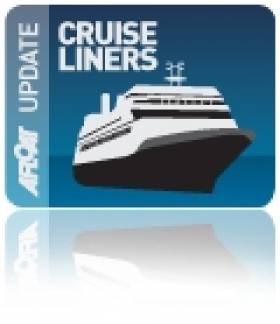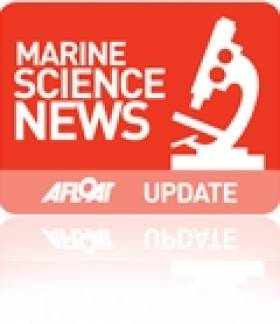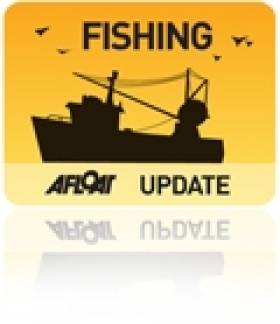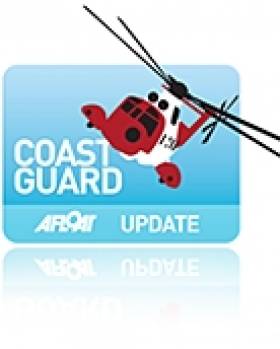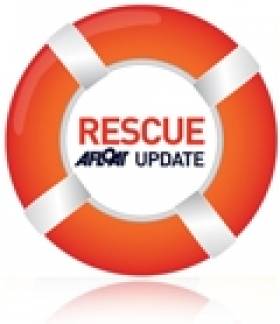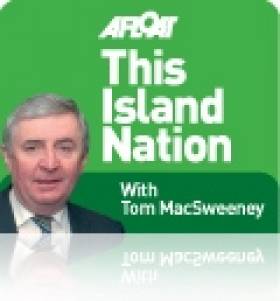Displaying items by tag: Killybegs
Killybegs First P&O Cruises Caller Sets Sail
#KillybegsP&O - Killybegs first visitor from P&O Cruises, the 30,000 tonnes Adonia set sail last night as a lone piper played on the pier to mark her departure.
Adonia had arrived in the port yesterday morning with about 700 passengers on board.
The master of the cruiseship, Captain David Box, called in at the Killybegs Information Centre and presented a commemorative plaque to Manager, Anne Dorrian, and the team.
For more on the debut call of the prestigious cruise operator, see yesterday's DonegalNow.com
Another P&O caller and the largest ever cruiseship due to Killybegs as Afloat previously reported is the 69,000 tonnes Oriana on 26 June.
The 1,800 passenger ship is one of a record breaking season of eight cruise callers this year to visit the north-west port.
Largest Cruiseships to Killybegs to Visit in 2015
#Cruiseliners - Killybegs Information Centre has confirmation through Sinbad Marine Services that three visits to the port in 2015 have been scheduled by the prestigious brand P&O/Carnival Lines.
The cruiseships to visit Killybegs under the P&O Cruises flag will be the largest passenger ships so far to use the port. Among the brands of Carnival Group are famous lines such as Cunard, Princess Cruises and Holland America Line.
P&O's Adonia is due in port on June 17 and will return for a second visit on July 21. A second P&O Cruises fleet-member Oriana, which is twice the size, is due to berth on June 26.
The calls by P&O brings to a total of eight callers confirmed for 2015, and passenger figures visiting Killybegs next year is greater than last year's season, itself a record.
The 30,000 tonnes Adonia, with a length of 180.45 m (592 ft) is smaller by comparison to the 69,000 tonnes Oriana with a length of 260.00 m (853.02 ft).
Adonia has a capacity for more than 800 passengers while Oriana has a maximum capacity of more than 1,900 passengers with a crew of just under 800 (794).
Anne Dorrian of the Killybegs Information Centre said "This is great news and we hope it will lead to even bigger vessels visiting Killybegs in the future".
"The Adonia is a pathfinder ship, exploring ports which the larger ships of today had not previously considered. Hopefully, her visit will pave the way for some of the most splendid ships in the Carnival fleet to come to beautiful County Donegal."
She added "Between 2009 and 2014, there have been 52 visits by cruise ships to Killybegs with over 22,000 passengers and more than 6,000 crew. In 2015, the eight ships confirmed will bring an estimated 6,300 passengers to the town.
Carnival Cruise Lines is a British-American owned company, based in Florida and the brand is one of ten forming Carnival Corporation & plc.
The line has the largest fleet in the group, with 24 vessels accounting for more than 21% of the worldwide market share.
#marinefood – A proposed joint venture project by Killybegs Fishermen's' Organisation (KFO) and Norwegian firm Biomarine Science Technology (BST) will, subject to planning permission, State Aid, and the approval of Enterprise Ireland, create up to 50 jobs during construction.
A further 70 jobs will be created when full production commences at the end of 2016. The Plant will extract high-end proteins, oils and calcium from fish for use as food ingredients and will initially have the capacity to process up to 50,000 tonnes of raw material annually.
Simon Coveney TD, Minister for Agriculture, Food and the Marine today attended an information launch by Biomarine Ingredients Ireland (BII) of their plans to build the largest marine food ingredients plant in the world in Killybegs, Co. Donegal.
The Minister said "With increasing food ingredient prices and a shortage of quality protein in the market, there is a significant opening for the products which this new venture can produce. The increased focus on health and rising demand for foodstuffs high in healthy content has led to rapid growth in the global health and sports nutrition market. This new venture can become a key player in that market and will bring much needed employment to Killybegs and the North West Region. Killybegs is the perfect location for this new facility, with Ireland's 70% share of the EU quota for boarfish, the main input raw material for this new venture, and with KFO members landing 40,000 tonnes of this species in 2013. I am working closely with all involved to help bring this proposed project to fruition".
#multibeam – A new multibeam sonar system fitted to the Marine Institute's Research Vessel Celtic Voyager will allow a new level of detail of seabed features to be captured during important mapping surveys around our coast.
It will greatly increase the capability of the vessel to acquire seabed bathymetry data as part of the INFOMAR seabed mapping program and other projects.
See how the new sonar operates in the promo vid below.
The new EM2040 system will be the primary mapping tool during upcoming INFOMAR survey operations offshore County Galway, Clare, and West Cork, extending the Irish seabed coverage around our coast.
This seabed mapping activity will support ocean energy development and fisheries management, and provide improved navigation for safe shipping and transport.
It was successfully installed onboard the RV Celtic Voyager during a recent dry docking in Killybegs, Co. Donegal.
The EM2040 system which was purchased from Kongsberg Maritime was installed on the vessel at the Department of Marine shipyard in Killybegs by P&O Maritime with the assistance of Mooney Boats of Killybegs.
This system replaces an older system which has been in use since 2000.
#Seafood - Marine Minister Simon Coveney has welcomed plans by the Killybegs Fishermen’s’ Organisation (KFO) and a Norwegian partner to build the largest marine food ingredients plant in the world in Killybegs, Co Donegal.
The plant, due to become fully operational by 1 January 2017, will produce valuable high-end marine protein for human consumption.
“This facility will become a ‘game-changer’ in the seafood sector," said the minister in his opening address at the BIM National Seafood Conference at Dublin's Aviva Stadium yesterday 2 April.
"It will position Killybegs and Ireland as a global leader in supply and research around new products and benefits from protein, oils and calcium associated with the sea," he added.
"This new processing facility arises from the new boarfish fishery which was developed by Irish fishermen over the past few years. In 2012, the EU introduced quota shares for the stock and Ireland secured 70% share of the fishery and has a quota of 88,000 tonnes in 2014.
"I am delighted that the new food ingredients project will maximise the value of a significant part of this fishery and centre the associated economic activity and jobs in the heartland of Ireland’s fishing community."
Minister Coveney confirmed that while the plans are at an early stage, “discussions are underway to finalise the full funding of the project. I look forward to the successful conclusion of these negotiations and to a formal announcement of this project in Donegal.
"KFO chief executive Sean O’Donoghue has invited me to Donegal to announce specific details of the project on 9 May, which I’m very pleased to accept subject to successful conclusion of the ongoing discussions.”
The focus of the conference, hosted by Bord Iascaigh Mhara and attended by seafood business leaders, global industry thinkers and world-renowned fisheries experts, was ‘capturing Ireland’s share of the global seafood opportunity’.
Minister Coveney added: “We all need to challenge our thinking and inform ourselves of best international practice so that Ireland will be able to position itself to maximise its share of the global seafood opportunity.
"Ireland may currently be a small player in the context of world seafood, however, given the huge resources around our coast it is clear that we should have major ambitions for sustainable growth of our seafood sector. This conference will contribute to making these ambitions a reality and the Killybegs food ingredients projects shows what can be done.”
#coastguard – Minister for Transport, Tourism & Sport Leo Varadkar has opened the newly-built Coast Guard Station in Killybegs which provides the voluntary crew with top-class accommodation and training facilities.
It's the third new Coast Guard building opened by Minister Varadkar since the election, and a fourth new premises will open at Doolin in the next few months. Minister Varadkar is hoping to open at least one new Coast Guard facility every year for the life-saving Coast Guard volunteers.
Minister Varadkar also confirmed that the Coast Guard has commenced a new round of recruitment for radio officers for its three monitoring stations in Dublin, Valentia and Malin.
Speaking at the opening, Minister Varadkar said: "I'm delighted to open this superb, purpose-built Irish Coast Guard Station and pollution control centre. I want to thank the Coast Guard volunteers for their service and dedication to our coastal communities. This commitment is truly impressive and the Government is acutely aware of its importance. I'm pleased to announce that since my appointment as Minister, this is the third new station that we have opened for the Coast Guard volunteer sector."
The new Coast Guard station is located at the inner mouth of Killybegs Harbour on the new pier. The combined facility consists of a three story Coast Guard Station and an adjoining single storey Pollution Control Store. It provides volunteers with a safe and comfortable working environment, and secure, water-proof storage facilities for their life-saving equipment.
The Pollution Control Store at Killybegs is one of three regional centres used by the Coast Guard. It provides a base for the 25 volunteer members of the Killybegs Coast Guard team who are trained and equipped to operate as a boat team, cliff rescue and coastal search unit.
Irish Coast Guard Director Chris Reynolds said: "I am delighted to have this opportunity to welcome our many friends to Killybegs today on what is a proud day for Killybegs and its harbour. I extend a special welcome to representatives of the statutory and voluntary services including the Gardaí, RNLI, HSE, Navy, Fire Service and local authorities. I wish to thank Killybegs Coast Guard Unit for their many years of service to their community."
Killybegs Coast Guard Unit Officer in Charge Arthur Kee said: "This is a special day for the volunteer members of Killybegs Coast Guard Unit, for the town and surrounding community. On behalf of the unit I would like to thank the Minister and all those involved with the project including the OPW, Donegal County Council, the Department of Agriculture, Food & the Marine, whose assistance with site provision is greatly appreciated, and the local Harbour Master Martin Connell."
Since 2011 new Coast Guard buildings have been opened in Goleen in West Cork, and Crosshaven in Co. Cork. The new buildings are a huge leap forward for the volunteers and replace the old garage buildings known as 'rocket houses'.
The new Coast Guard Station at Doolin, the busiest Coast Guard Station in Ireland, is expected to open within the next few months. Meanwhile planning is underway for new Stations at Westport in Co. Mayo and Greystones in Co. Wicklow.
Man Killed In Killybegs Fish Processing Plant
#Killybegs - Various news outlets are reporting that a man has died after a freak accident at a fish processing plant in Killybegs in Co Donegal yesterday afternoon (10 January).
The Irish Independent has named the deceased as Kara McCole, a 21-year-old man from nearby Inver working as a forklift driver at the Sean Ward Fish Exports factory.
The man is said to have become trapped in machinery in a part of the plant where cartons are stripped, according to The Irish Times.
RTÉ News says the Health and Safety Authority is investigating the incident, which is the first workplace fatality of the year in Ireland.
Elderly Woman Survives Fall From Europe's Highest Sea Cliff
#Rescue - An elderly woman was rescued on Thursday 11 July after slipping off the highest sea cliff in Europe.
The Belfast Telegraph reports that 71-year-old Vera Flynn became separated from her sister while walking the cliff path at Slieve League in Co Donegal.
According to the Donegal Democrat, it's believed she took a wrong turn on the path and slipped down the cliff face, becoming trapped in a ravine 400 metres from the top.
After a search lasting many hours, the woman was located by the Killybegs Coast Guard cliff rescue team and winched to safety, reportedly uninjured in her ordeal.
“There’s no doubt that this lady’s exceptional fitness helped her in this situation, given that she was out such a long time and it was such a hot day," said Killybegs coastguard press officer Shane McCrudden.
#marinas – Dinny McGinley TD Minister of State at the Department of Arts, Heritage and the Gaeltacht welcomed the approval by his colleague Simon Coveney TD, Minister for Agriculture Food and Marine, of the development of a Small Craft Harbour at Killybegs Fishery Harbour Centre.
Welcoming this development Minister McGinley said "the proposed Small Craft Harbour will provide a safe and modern facility for current harbour users including small fishing boats, passenger and angling vessels and leisure craft. The new facility, when complete, will also provide short term berthage for visiting leisure craft."
"I have long been aware of the benefits of a marina at Killybegs Fishery Harbour Centre. As local representative for this area, I have down through the years read with interest a number of reports on Killybegs and the Fishery Harbour Centre in the past and the benefits for the local community that would accrue from such a development ."
The funding will be provided under the 2013 Fishery Harbour and Coastal Infrastructure Capital Development Programme to kick start the development of a Small Craft Harbour at Killybegs Fishery Harbour Centre.
Officials of the Department of Agriculture, Food and Marine will set out a design and strategy to build the Small Craft Harbour in stages to meet demand while remaining cognisant of the current funding constraints and to deliver the first phase at the earliest opportunity.
#islandnation – The FISH IRELAND Exhibition in Killybegs, the Volvo Race in Galway, the Round Ireland Race at Wicklow, commemorating an Arctic hero in Courtmacsherry and where is the summer for sailing? That's quite a mix of maritime material for one week. At least the Volvo is generating more attention to the marine scene in the general media. It is a regrettable that the same attention is not continued throughout the year.
WICKLOW - FISH, YACHTS AND DENNIS NOONAN
Looking out the window of the Race Office perched high above the quay wall at Wicklow, Dennis Noonan recalled his days of sailing Enterprise dinghies at Baltimore in West Cork:
"They challenged your ability. A mistake at a gybe mark and you could end up in the water. You needed to concentrate, but they were a great way to learn sailing," and he chuckled at the memory, then pointed at the cruisers rafted up at the quayside, tugging at their moorings, seeming anxious to get away: "Offshore racing is a different type of sailing, but no less challenging when you take on the coast of Ireland, no matter what the size of the boat."
Dennis is the doyen of the Round Ireland Race which he was describing to me.
"I've stepped back a bit now," he said, waving at the busy office team putting the final arrangements in place for the start of the race when we talked on the evening before the start. The following day he sent 37 yachts off on their 704-mile voyage. "I have to live by the sea," he told me.
Sailing needs determined people like Dennis who, from his time as a boat builder, continues to build lovely model boats.
MORE FISHING BOATS AT WICKLOW
I noted the number of inshore fishing boats tied up at the quayside in Wicklow, as I am sure crews on the yachts gathered for the Round Ireland start also did. It seems that there is good whelk fishing off Wicklow which has attracted the boats and that the port provides better landing facilities than Arklow which had been the dominant fishing port on the Wicklow coastline.
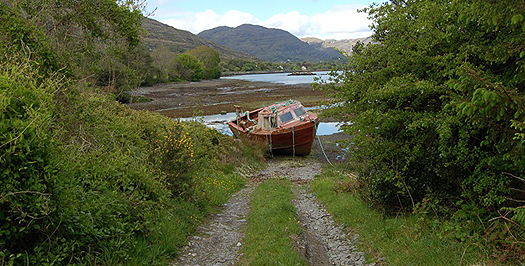
FISH IRELAND KILLYBEGS
These are tough times for the fishing industry and I have been hearing many stories of those difficulties at THE MARINE TIMES FISH IRELAND EXHIBITION in Killybegs. The problems are extensive – from limited quotas to the massive amount of regulations and it is not good to see fishing boats tied up at the quayside prevented from going to the fishing grounds by EU regulations. There are few industries where the official approach is to stop men from working. All this while foreign vessels continue to fish in Irish waters because their quotas are so much larger than those of Irish vessels. There is no doubt that politicians have made a complete mess of the fishing industry.
The small Irish fishing fleet could not have fished Irish waters to the low state of some stocks at present, but this fact is ignored by sensationalist commentaries in the general media where the facts of fishing and maritime life are not understood and there is insufficient expression of an opposite viewpoint. To see areas of Killybegs shuttered which should have viable fish-related industrial activities is disappointing and some of this is due to the attitude of Irish government officials who have frustrated development and stopped proposals which would have created jobs by imposition of unreasonable rents and regulations. It makes me wonder about the government's commitment to job creation.
There are other issues to be addressed, such as the differing reports from environmentalists, scientists, fishermen and leisure anglers about cod stocks. While environmentalists and scientists claim cod has disappeared from Irish waters, anglers report catching more than ever before and fishermen, who are controlled in catching them say the waters are alive with cod. So who is right – those who go out and see for themselves or land-based opinion?
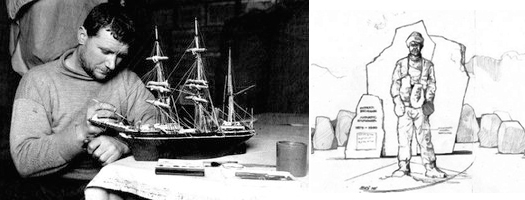
KEOHANE TO BE HONOURED IN COURTMAC
A project is underway in Courtmacsherry in West Cork, I am told, to honour the role of local man Patrick Keohane in Arctic exploration. He was one of those who located the bodies of Robert Falcon Scott and others from the Discovery Expedition of 1901-1904 near the South Pole. The location for a memorial to him is likely to be within view of his birthplace at Barry's Point on the route of the Seven Heads Walkway. A local committee is raising finance for the memorial. Unveiling day is likely to be Sunday, August 19. Well done to the people of Courtmacsherry.
This is an artist's impression of the sculpture.
ARCTIC
According to the Research Council of Norway the Arctic may contain more than a fifth of the Earth's undiscovered oil and gas. Increasing pressure on the region is indicated by shipping cargoes which will reach their highest level through the area this year as companies cut costs and fuel consumption by avoiding the Suez Canal. A thousand tonnes of fuel, costing over $600,000 dollars, can be saved. The environmental importance of the Arctic has been shown by the discovery of a 60-mile bloom of phytoplankton beneath the Chukchi Sea in the Arctic, regarded as "astonishing" by scientists. Phytoplantkon is the essential food of marine life.
WHERE IS IRISH AWARENESS?
Seafarers' Awareness Week, an annual campaign by the biggest charity helping seafarers in need – Seafarers UK – has just concluded. The charity works to raise awareness of Britain's dependence on seafarers and gives annual grants of more than stg£2 million to help seafarers, their families and dependants across the Merchant Navy, Fishing Fleets and the Royal Navy. What a pity there is not something similar in Ireland.
CONCORDIA CAPTAIN CHARGE WITH MANSLAUGHTER
Captain Francesco Schettino who commanded the cruise liner Costa Concordia is now charged with multiple manslaughter, causing the accident and abandoning ship prematurely. Italy's top appeals court has held that he should face the charges, indicating that he was unfit to command.
AMAZON NOW UNDER THREAT
Twenty-two hydro-electric schemes are planned to be built along the Amazon River and its tributaries. Environmentalists and indigenous rights campaigners claim this will alter the environmental and social balance and that the rain forest and tribes which live there will be permanently damaged as locals are removed to for construction work in remote areas. The power schemes are required to meet Brazil's burgeoning demand for electricity as the country develops economically.
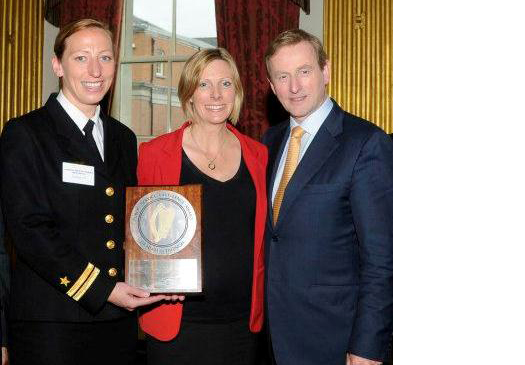
IMERC HONOURED BY TAOISEACH
I was delighted to see that IMERC, the Maritime and Energy Resource Cluster at the National Maritime College in Ringaskiddy, whose work I have praised previously, was awarded this year's "Public Service Excellence Award" by Taoiseach Enda Kenny.
The award highlights the opportunities for job creation and economic growth in the marine sector and the importance of realising the economic potential of Irish marine resources. IMERC was chosen from 190 projects. It is a tripartite alliance between the Naval Service, UCC and the Cork Institute of Technology Development. This is the first time a maritime project has featured in the awards since they were initiated in 2004.
Val Cummins directs the team which is developing the world's largest marine renewable energy research facility at Ringaskiddy. Congratulations to them on their well-deserved award.
Email your comments to THIS ISLAND NATION at [email protected]
Follow Tom MacSweeney on Twitter @TomMacSweeney and on Facebook – THIS ISLAND NATION



























